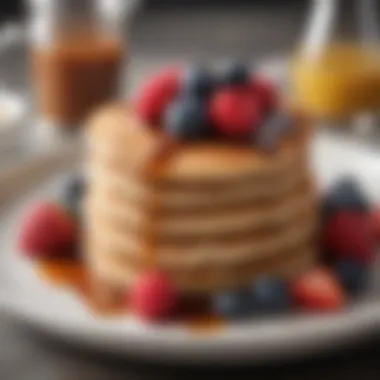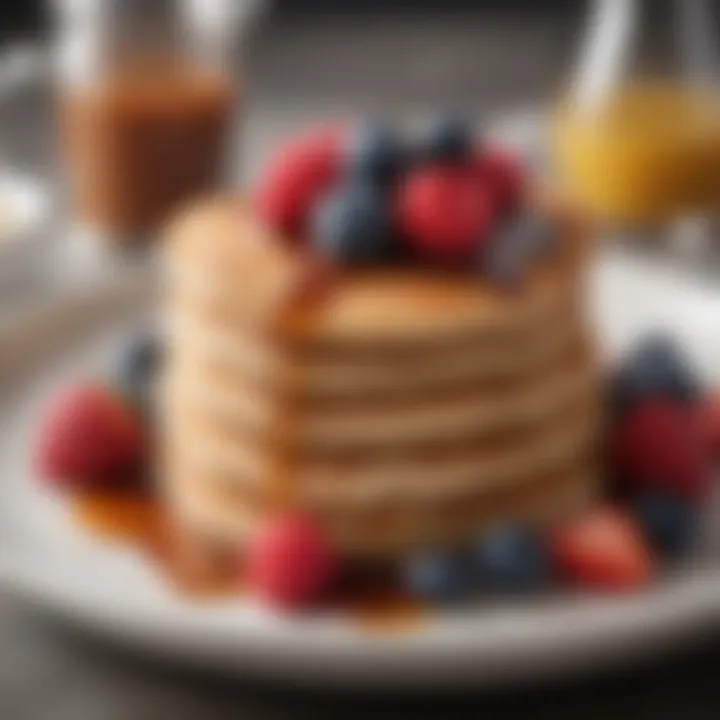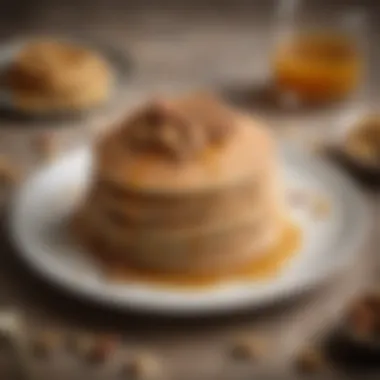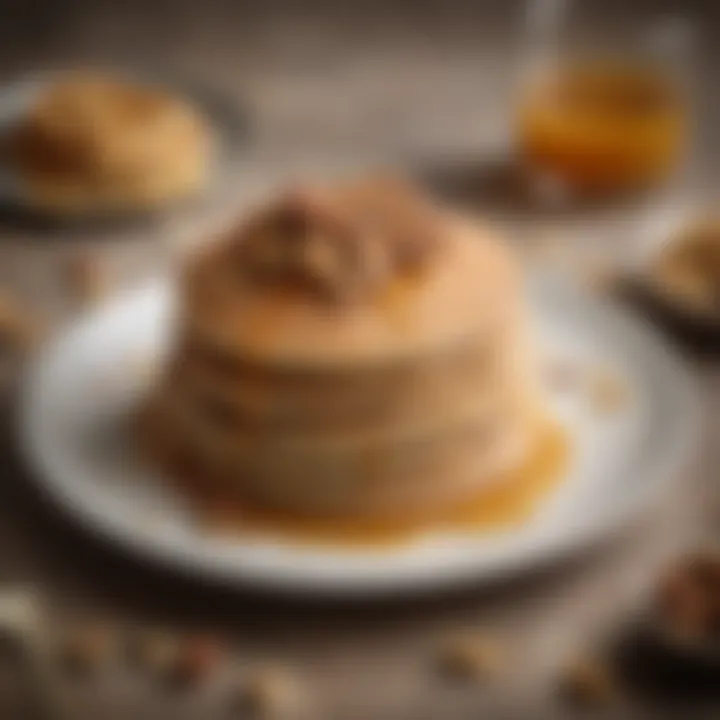The Ultimate Guide to Oat Pancakes: Recipe & Tips


Intro
Oat pancakes have gained popularity in recent years, appealing to those who seek healthier alternatives to traditional pancakes. Made primarily from ground oats, these pancakes offer a unique texture and a distinct flavor that sets them apart. Beyond their taste, oat pancakes are packed with nutrients, making them a favorable choice for breakfast or brunch.
Their versatility allows for numerous variations, catering to different dietary preferences. With the rise of gluten-free, vegan, and plant-based diets, oat pancakes efficiently accommodate these needs. This guide explores the essential components of cooking oat pancakes and provides insights into their nutritional benefits and creative recipe alternatives.
Prologue to Oat Pancakes
Oat pancakes have gained remarkable popularity in recent years, partly due to a growing awareness of healthy eating habits. They offer an alternative to traditional wheat-based pancakes, especially for those seeking gluten-free or whole-grain options. This section will elucidate the significance of oat pancakes, discussing not only their nutritional advantages but also their versatility in various dietary contexts.
Nutritional Importance
Oats are a powerhouse of nutrients. They are rich in fiber, particularly beta-glucans, which can help lower cholesterol levels. This is an important consideration for health-conscious individuals. By integrating oats into pancakes, one can elevate a simple breakfast into a nutrient-dense meal.
Versatility and Adaptation
Another important element of oat pancakes is their adaptability. The base recipe can be modified to cater to different dietary requirements, such as veganism or gluten intolerance. This makes oat pancakes an appealing dish for a diverse group of people, spanning from children to adults. Creating a delicious pancake that fits individual dietary needs can be a very rewarding experience.
Culinary Exploration
The ease of mastering oat pancake recipes is also noteworthy. With few ingredients required, they allow for a culinary exploration that is accessible to novice cooks and seasoned chefs alike. This introductory section sets the stage for diving deeper into the world of oat pancakes, guiding readers through the intricate details that celebrate this flexible dish.
"Oat pancakes are not just meals; they are a canvas for creativity in the kitchen."
Nutritional Profile of Oats
Oats are often celebrated for their impressive nutritional profile. They consist of a variety of essential nutrients, making them a valuable addition to any diet. Understanding the nutritional composition of oats is crucial for anyone looking to enhance their meals with nutrient-dense ingredients. The high fiber content, vitamins, and minerals present in oats not only contribute to their health benefits but also play a significant role in balancing overall dietary needs.
Vitamins and Minerals
Oats contain a broad spectrum of vitamins and minerals, which are essential for maintaining various bodily functions. Key vitamins found in oats include Vitamin B1 (thiamine), Vitamin B5 (pantothenic acid), and Vitamin B6. These vitamins support energy metabolism and the functioning of the nervous system. Additionally, oats provide important minerals like manganese, phosphorus, copper, iron, and magnesium. Each of these minerals helps in processes such as bone health, energy production, and oxygen transportation in the blood. Incorporating oats into your diet can help ensure you meet your daily nutrient requirements, supporting overall well-being.
Fiber Content
One of the standout features of oats is their high fiber content, particularly soluble fiber known as beta-glucan. This type of fiber is renowned for its ability to regulate blood sugar levels, enhance satiety, and lower cholesterol. A serving of oats can contain approximately 4 grams of dietary fiber. Including fiber-rich foods in your daily diet promotes digestive health and can help prevent constipation. Furthermore, higher fiber intake is associated with a lower risk of developing chronic diseases such as heart disease and diabetes. Eating oats regularly can significantly support a healthy digestive system and may play a role in weight management.
Health Benefits
The health benefits of oats are numerous and well-documented. Regular consumption of oats can lead to improvements in heart health due to their cholesterol-lowering properties. They aid digestion and may contribute to weight loss by promoting feelings of fullness. Additionally, the presence of antioxidant compounds called avenanthramides in oats may help to reduce inflammation and protect against heart disease. Oats also have a low glycemic index, making them an ideal food choice for those looking to manage their blood sugar levels effectively. Thus, integrating oats into meals can offer both immediate and long-term health advantages that contribute to an overall healthier lifestyle.
"Oats are a powerhouse of nutrients that provide essential health benefits, making them a smart choice for anyone looking to improve their diet."
History of Pancakes
The story of pancakes is as diverse as the recipes themselves. This section explores their evolution over centuries and across cultures. Understanding the history of pancakes not only enriches the culinary experience but also connects modern eaters to ancient traditions. Pancakes serve as a canvas for regional tastes and preferences. This exploration can deepen appreciation for the complexities behind what is often considered a simple dish.
Cultural Significance
Pancakes hold a significant place in many cultures worldwide. They often symbolize comfort, indulgence, and home cooking. In different countries, pancakes may take on unique forms and flavors, reflecting local ingredients and cooking styles. For instance, crepes from France are thin and delicately prepared, while American pancakes tend to be thicker and fluffier.
Pancakes are part of many cultural celebrations. In the United States, they are a staple of breakfast and often associated with family gatherings. In Russia, blinis are traditionally served during Maslenitsa, marking the end of winter. The international appeal of pancakes is undeniable, as they can be sweet or savory, eaten at any time of day, and frequently adapted to suit dietary restrictions.
Traditional Recipes
Many traditional recipes exist that showcase how pancakes have been prepared across cultures. Here are some notable examples:
- American Buttermilk Pancakes: Fluffy and light, these pancakes are made with buttermilk, giving them a unique tangy flavor and soft texture.
- Japanese Okonomiyaki: A savory pancake made with cabbage, meat, and seafood, which is cooked on a hot griddle and topped with mayonnaise and sauce.
- French Crepes: Thin pancakes filled with a variety of ingredients, from Nutella to ham and cheese, demonstrating versatility.
- Ethiopian Injera: A sourdough flatbread with a spongy texture, it serves as both a plate and food, often paired with stews.
These recipes reflect not only the taste preferences of each culture but also the historical and social contexts. Each pancake type has its own narrative, showcasing the ingenuity and creativity of various culinary heritages. Embracing this rich history allows modern cooks to appreciate the enduring legacy of pancakes in our diets.
Ingredients for Oat Pancakes
The ingredients used in oat pancakes must be chosen thoughtfully. They determine the nutrition, flavor, and texture of the final dish. Understanding each element allows cooks to achieve the desired outcome and cater to different dietary needs. Oat pancakes stand out because they offer healthier alternatives to traditional wheat-based recipes. Their versatility also accommodates numerous additions and variations.
Base Ingredients
The base ingredients for oat pancakes typically include:
- Rolled Oats: Ground into a flour-like consistency, they provide structure. They also contribute to the pancakes' characteristic flavor.
- Milk or Plant-Based Milk: This ingredient provides hydration. It can be dairy, almond, soy, or oat milk, depending on dietary preferences.
- Eggs or a Substitute: Eggs bind the mixture. If avoiding animal products, masy banana or flaxseed can be used as substitutes.
- Baking Powder: This leavening agent ensures the pancakes rise, creating a light and fluffy texture.
- Salt: A small amount enhances flavors.
These base ingredients interact to create a batter that is both pleasing in taste and suitable for different dietary considerations.
Optional Additions
Customization can enhance the base recipe. Consider including the following:
- Sweeteners: Honey, maple syrup, or agave can add sweetness. They can be adjusted based on personal preference.
- Spices: Cinnamon, vanilla extract, or nutmeg can deepen the flavor profile.
- Fruits: Blueberries, sliced bananas, or grated apples can introduce natural sweetness and texture. They also pack extra nutrition.
- Nuts: Chopped walnuts or pecans offer crunch, as well as healthy fats.
Integrating these additions provides an opportunity to adapt the pancakes to various tastes and dietary needs.
Choosing the Right Oats
Selecting the correct type of oats is crucial for the texture and health benefits of oat pancakes. Rolled oats are the most common choice. However, quick oats may also work if time is a constraint. They will yield a softer pancake. Steel-cut oats, on the other hand, require a longer cooking time and may need to be soaked. This increases their digestibility.
Each type of oat presents its own benefits and cooking properties:
- Rolled Oats: Good balance of texture and nutrition; easy to blend into a fine flour.
- Quick Oats: Streamlined preparation, hence ideal for a busy kitchen.
- Steel-Cut Oats: Nutrient-dense and may offer a heartier texture if prepared properly.
Ultimately, personal preference will guide the choice, influencing not only taste but also nutritional content.
Preparing the Oat Batter


The preparation of the oat batter is a pivotal stage when making oat pancakes. It lays the foundation for both texture and flavor. A well-prepared batter can elevate the dish, making it light and fluffy while maintaining the wholesome goodness of oats. Understanding the steps involved is essential for anyone who wants to master the art of oat pancakes.
Blending Techniques
The blending process is crucial for achieving the right consistency. When making oat batter, you can use either a blender or a food processor. Each method comes with its own benefits. A blender tends to yield a smoother mixture, while a food processor can handle larger quantities more easily.
- Start with the oats: You may use rolled oats or quick oats, depending on the texture you prefer. If you desire a smoother pancake, you can blend the oats first to create oat flour.
- Add wet ingredients: Incorporating ingredients like milk, eggs, and oil helps in achieving a blend that is smooth and combined well. Make sure to add these gradually to control the consistency.
- Pulse and scrape: Use short pulses and pause to scrape down the sides. This will ensure that all ingredients are finely mixed, avoiding lumps.
- Monitor the blending time: Over-blending can lead to a gummy batter. A quick blend until everything is smooth is ideal.
Consistency Considerations
The thickness of the batter directly influences the final outcome of the pancakes. The desired consistency often falls between a pourable liquid and a thick paste. Here are a few considerations:
- Too thick: If the batter is too thick, the pancakes may turn out dense and heavy. Adding a bit more liquid will help.
- Too thin: A batter that is too runny may not hold its shape during cooking. In this case, adding more oats or a thickening agent can improve the situation.
- Testing: A simple test involves dripping a small amount of batter onto a plate. If it flows too easily, it may need thickening. If it holds its shape, it’s likely at the right consistency.
"The right batter consistency is key to achieving fluffy, delightful oat pancakes. Paying attention to this aspect can significantly enhance your culinary results."
Cooking Methods
Understanding the various cooking methods for oat pancakes is essential in achieving not only the desired texture but also enhancing flavors. Different techniques can yield different outcomes in terms of taste and presentation. For instance, cooking on a stovetop often results in a soft and fluffy pancake, whereas baking can produce a more uniform and slightly crisp texture. Each method provides unique benefits and can cater to different preferences, dietary needs, and cooking environments.
Stovetop Cooking
Stovetop cooking is one of the most common and traditional methods for preparing oat pancakes. This process allows for direct contact with the heat source, facilitating a quick cooking time that leads to a delightful texture. The key to successful stovetop cooking lies in controlling the heat. A medium heat setting is generally recommended to prevent burning while allowing the pancakes to cook through completely.
Here are some considerations related to stovetop cooking:
- Pan Type: Nonstick pans are ideal for ensuring that the batter does not stick, while cast iron options can provide a nice crispy edge and even heat distribution.
- Cooking Fat: Using butter or oil in moderation can also enhance flavor while preventing sticking. Consider using coconut oil for a subtle tropical twist.
- Flipping Technique: Wait for bubbles to form on the top before flipping the pancake. This usually indicates that the bottom is adequately cooked.
- Batch Cooking: If making multiple pancakes, keep space between them to allow for even cooking and easy flipping.
In summary, stovetop cooking provides versatility, faster cooking time, and an opportunity to customize each pancake with varied toppings and flavors as they cook.
Baking in the Oven
Baking oat pancakes in the oven is an efficient approach, especially for preparing larger batches. This method results in a consistent texture throughout each pancake, making it ideal for those who want to serve breakfast for a group without the hassle of cooking each one individually on the stove. Baking may also make them a bit fluffier due to the controlled environment of the oven.
To successfully bake oat pancakes, pay attention to the following:
- Oven Temperature: Preheat the oven to around 350°F (175°C) to ensure proper cooking. A consistent temperature is crucial for evenly baked pancakes.
- Baking Sheet Preparation: Line the baking sheet with parchment paper or a silicone mat to prevent sticking. This also helps with cleanup afterward.
- Pancake Size: Pour the batter into individual circles on the baking sheet, leaving enough space for them to spread slightly.
- Cooking Time: Baking usually takes about 15 to 20 minutes, but checking for doneness is essential. A toothpick inserted in the center should come out clean.
Baking combines ease and efficiency, making it an attractive option for meal prep or gatherings.
"Whether opting for stovetop cooking or baking, each method enhances the appreciating of oat pancakes and their versatility in the kitchen."
Serving Suggestions
Serving suggestions for oat pancakes are essential in enhancing the overall dining experience. Pancakes, while nutritious, can sometimes benefit from additional flavors and textures. By carefully selecting syrups, sauces, and toppings, one can elevate a simple stack of oat pancakes into an impressive meal that pleases the palate. Moreover, the beauty of pancakes lies in their versatility, enabling individuals to cater to various dietary preferences and seasonal ingredients.
Syrups and Sauces
Syrups and sauces play a pivotal role in defining the taste of oat pancakes. While traditional maple syrup is a timeless choice, there are many other options to consider. For example, honey can be drizzled for its natural sweetness and additional health benefits. Agave nectar serves as a great vegan alternative.
Other notable sauces might include blueberry or raspberry compotes, which add vibrant color and contrast. These fruit-based options can provide not just sweetness, but also nutritional benefits from the added fruit content. A simple yogurt sauce sprinkled with herbs can also give a refreshing tang that cuts through the richness of the pancakes, adding an elegant twist.
Consider trying the following:
- Maple Syrup: Classic and rich in flavor.
- Honey: Offers a floral note and healthful sweetness.
- Fruit Compotes: Fresh or cooked fruits blended into a sauce.
- Nut Butters: Peanut or almond butter adds creaminess and depth.
Exploring beyond traditional options can open new horizons for flavors and textures.
Fruit and Nut Toppings
Fruit and nut toppings provide an excellent way to enhance not only the aesthetic but also the nutritional value of oat pancakes. Fresh fruits, such as sliced strawberries, bananas, or blueberries, can introduce natural sweetness and moisture. The vibrant colors of these fruits also make the dish more inviting.
Nuts such as walnuts, pecans, or almonds bring crunch and protein, balancing the soft texture of the pancakes. Combining these elements creates a symphony of flavors, ensuring a delightful and satisfying meal.
Examples of effective combinations include:
- Sliced Bananas and Almond Butter: A classic pairing with nutty richness.
- Blueberries and Greek Yogurt: Adds creaminess and protein.
- Chopped Walnuts and Honey Drizzle: For a crunchy and sweet experience.
Incorporating these suggestions not only caters to individual taste preferences but also adds diversity and nutrition to every meal.
Customization Options
Customization Options for oat pancakes presents a vital avenue for creativity in the kitchen. This flexibility caters to diverse dietary needs and personal taste preferences, allowing anyone to enjoy oat pancakes regardless of their restrictions. The potential for variety enhances the overall experience of preparing and consuming these pancakes, making both the act of cooking and the meal itself more enjoyable.
Gluten-Free Alternatives
For individuals with gluten sensitivity or celiac disease, creating a gluten-free pancake is crucial. Fortunately, oats are inherently gluten-free, but cross-contamination can occur during processing. Therefore, seeking certified gluten-free oat products is essential.
In addition to using gluten-free oats, there are several other alternatives that can be pondered:
- Almond Flour: This flour adds nuttiness to the pancakes while boosting healthy fats.
- Coconut Flour: It absorbs moisture well, so only small amounts are required in combination with other flours.
- Rice Flour: A fine choice that provides a light texture, often favored in many gluten-free recipes.
When customizing oat pancakes for gluten-free preferences, attention to the thickness of the batter is necessary. It might be more fluid than traditional mixes due to the alternative flours. Adjusting liquid ingredients can make it easier to achieve the right consistency.
Vegan Variation
Adapting oat pancakes for a vegan diet is another way to customize this dish without sacrificing flavor or texture. Substituting animal products with plant-based ingredients is straightforward and yields delicious results. Key substitutions include:
- Egg Replacement: Using mashed bananas, ground flaxseed mixed with water, or applesauce can act as binders
- Non-Dairy Milk: Options like almond milk, oat milk, or soy milk provide needed liquid without animal products.
- Sweeteners: Maple syrup or agave nectar can replace honey to keep it vegan friendly.
This adaptability not only serves dietary preferences but also introduces unique flavor profiles. Each vegan version can carry its own distinct taste, enticing any palate.


"Customization is the bridge between typical meals and extraordinary culinary experiences."
By embracing these customization options, oat pancakes can become a versatile dish that fits into various dietary restrictions and personal tastes, fostering inclusivity in the kitchen. Each alteration opens the door to new culinary adventures.
Storing and Reheating Tips
When you make oat pancakes, it is common to have leftovers. Understanding how to store and reheat these pancakes properly can enhance your culinary experience. As oat pancakes are nutritious and versatile, ensuring they are stored correctly will preserve their flavor and texture.
Proper Storage Techniques
Storing oat pancakes requires careful consideration to maintain their quality. Here are some effective methods:
- Cool Before Storing: Allow the pancakes to cool completely at room temperature. This prevents moisture build-up that can make them soggy.
- Layer with Parchment Paper: If you stack the pancakes, place parchment paper between each pancake. This prevents them from sticking together and makes it easier to separate them later.
- Airtight Containers: Use airtight containers or food storage bags. This minimizes air exposure, reducing the risk of spoilage. Be mindful of the size—use a container that minimizes excess air.
- Refrigeration: If you plan to use the pancakes within a few days, keep them in the refrigerator. They can last up to four days. If longer storage is needed, freezing may be a better option.
- Freezing for Longevity: For longer storage, consider freezing the pancakes. Place them in a single layer on a baking sheet until frozen solid, then transfer them to a freezer-safe bag or container. They can last for up to three months in the freezer.
Reheating Methods
Reheating is equally important to enjoy your oatmeal pancakes as they were intended. Here are some methods:
- Microwave: The quickest method is using a microwave. Place a pancake on a microwave-safe plate, cover with a damp paper towel, and heat for about 20-30 seconds. Check to see if it’s warm, repeating if necessary in small increments.
- Stovetop: For a crisper texture, use a skillet on medium heat. Place the pancake in the skillet without added oil and reheat for about 1-2 minutes per side. This method revives the flavor while maintaining a delightful texture.
- Oven Method: Preheat the oven to 350°F (175°C) and place pancakes on a baking sheet. Cover them with aluminum foil to prevent drying out. Heat for about 10 minutes. This is an effective way to reheat many pancakes at once.
Remember, proper storage and reheating methods not only preserve taste but also ensure the nutritional benefits of oat pancakes are maintained.
By mastering these tips, you can enjoy oat pancakes at their best, whether fresh off the stove or reheated from the fridge or freezer. Aim for quality, and your pancakes will remain a satisfying part of your meals.
Oat Pancakes in Popular Culture
Oat pancakes have carved a notable niche in contemporary culinary culture. Their emergence as a favored option reflects broader trends in health consciousness and sustainable food choices. The adaptability of oat pancakes has allowed them to integrate into various dietary preferences and cultural cuisines. As people become increasingly aware of their nutritional intake, oat pancakes present an appealing alternative to traditional recipes. They are versatile and can be easily modified to suit different taste profiles and dietary restrictions, making them a favorite among many food enthusiasts.
Social media platforms have played a significant role in the rise of oat pancakes. Instagram and TikTok, in particular, serve as platforms where culinary creativity thrives. Users frequently share eye-catching imagery and innovative recipes featuring oat pancakes, contributing to their growing popularity. The visual appeal of this dish, often garnished with fruits, nuts, and syrups, makes them enticing to a broader audience. This visibility not only increases engagement but also encourages individuals to explore making oat pancakes at home.
"Food is the common ground, a universal experience that connects us all. Oat pancakes are an excellent example of this connection, transcending cultural boundaries with nutritious benefits."
As more people share their oat pancake creations online, they inspire a sense of community among enthusiasts. This communal approach fosters the exchange of tips, recipes, and serving suggestions, solidifying the positioning of oat pancakes as a contemporary staple.
Social Media Trends
The influence of social media on food trends cannot be overstated. Oat pancakes have become a viral sensation, particularly among health-focused foodies. Various hashtags like #OatPancakes, #HealthyBreakfast, and #VeganCooking consistently trend on platforms such as Instagram and TikTok. This leads to widespread visibility of oat pancake recipes, which often feature unique spins on classic preparations. The ability to share visually appealing content allows for exponential growth in interest.
In addition, social media challenges encourage users to showcase their versions of oat pancakes. Users often experiment with ingredients, presenting options that cater to gluten-free, vegan, or low-carb diets, thus expanding the audience. The results are often shared in creative formats, drawing others into the world of oat pancakes. This pattern continues to propel the art of making these pancakes, highlighting both innovation and tradition.
Celebrity Chef Recipes
The popularity of oat pancakes has not gone unnoticed by celebrity chefs. Many have embraced this dish, incorporating it into their repertoire and promoting its versatility. Chefs like Jamie Oliver and Ella Mills frequently feature oat pancake recipes in their cookbooks and online platforms. Their influence helps elevate the status of oat pancakes from niche recipes to mainstream culinary offerings.
These chefs often share their unique takes on oat pancakes, experimenting with flavors and textures. For instance, adding matcha or cocoa powder to the batter introduces new tastes while retaining the nutritional benefits of oats. By integrating these elements, they not only appeal to a wider audience but also inspire home cooks to try making their own versions of oat pancakes.
Comparing Oat Pancakes with Other Pancake Types
In the culinary world, pancakes are a versatile dish enjoyed in various forms across cultures. When comparing oat pancakes with other pancake types, several factors come into play. This section explores nutritional differences and unique flavor profiles that set oat pancakes apart. Understanding these distinctions can help food lovers make informed choices based on their preferences and dietary needs.
Nutritional Comparisons
Oat pancakes are often praised for their health benefits, which arise from the nutritional content of oats. Unlike traditional pancakes made with white flour, oat pancakes provide a richer nutrient profile.
- Fiber Content: Oats are high in soluble fiber, which aids digestion and may help maintain heart health. In contrast, pancakes made with refined flours typically contain less fiber.
- Vitamins and Minerals: Oat pancakes deliver a variety of vitamins and minerals. For instance, oats are rich in B-vitamins, magnesium, and iron. Traditional pancake recipes may not offer these nutrients in the same manner, often relying on additives or toppings to enhance nutrition.
- Lower Glycemic Index: The glycemic index of oats is lower than that of white flour. This means oat pancakes may provide a steadier release of energy, which can be beneficial for managing blood sugar levels.
Overall, when looking to boost nutritional intake, oat pancakes present an enticing option for health-conscious diners.
Flavor Profiles
When it comes to taste, oat pancakes have unique flavor characteristics that can significantly differ from other pancake types. The flavors of pancakes can be influenced by the ingredients and preparation methods.
- Nutty Flavor: Oats impart a subtle nuttiness that enhances the taste of oat pancakes. This quality sets them apart from standard pancakes, which tend to have a milder flavor.
- Versatility in Flavorings: Oat pancakes easily accept various flavorings and additions such as cinnamon, vanilla, or almond extract. This adaptability allows for personalization that suits a range of tastes.
- Pairing Options: The natural flavor of oat pancakes complements many toppings, from maple syrup to fresh fruit. This capacity to pair well with diverse toppings gives oat pancakes an appealing edge in flavor exploration.
"The brilliance of oat pancakes lies in their ability to harmonize with both sweet and savory components, catering to diverse palates."
In summary, comparing oat pancakes with other pancake types reveals substantial differences in nutrition and taste. As culinary enthusiasts seek healthier alternatives or unique flavors, oat pancakes emerge as a compelling option worthy of consideration. Their benefits extend beyond mere sustenance, positioning them as a nutritious and enjoyable dish suitable for various diets.
The Science of Cooking Pancakes
The science behind cooking pancakes is intricate yet fascinating. Pancakes, including those made with oats, transform through various chemical reactions that enhance flavor and texture. Understanding these processes can greatly improve the cooking experience and the final product. Elements such as the Maillard reaction and the impact of temperature play crucial roles in creating a delightful pancake. Knowledge of these components helps cooks anticipate how different ingredients and conditions will affect the outcome, leading to consistently satisfying results.
Maillard Reaction
The Maillard reaction is a complex chemical process that occurs when proteins and sugars undergo heat. It is responsible for the browning of food and contributes to the rich, savory flavors that we often seek in cooked dishes. In the case of oat pancakes, this reaction begins as the batter hits the hot pan.
- Formation of Flavor Compounds: As the batter cooks, the Maillard reaction generates new flavor compounds that develop a unique taste profile.
- Visual Appeal: The browning enhances the visual aspect of the pancakes, providing a warm and appetizing color that signals doneness and quality.
- Texture: The Maillard reaction also adds to the pancake's texture, providing a pleasant contrast between the soft interior and slightly crispy exterior.
To maximize the benefits of this reaction, cooks should ensure an appropriate cooking surface temperature, avoiding too high or low heat.
Impact of Temperature
Temperature significantly influences pancake preparation and final texture. It affects both the cooking speed and the physical changes that occur as pancakes cook. Understanding the following points is essential:
- Optimal Cooking Temperature: A moderate heat setting is ideal. It allows for thorough cooking without burning the surface before the inside has set.
- Temperature and Cooking Time: Higher temperatures may lead to rapid surface browning, potentially resulting in uncooked centers. Conversely, too low a temperature can yield pancakes that are pale and undercooked.
- Flipping Timing: Knowing when to flip pancakes is also temperature-dependent. When bubbles form and begin to break on the surface, it often indicates that it's time to turn them over for even cooking.
Tip: Investing in a thermometer can help monitor pan temperature, ensuring each pancake achieves optimal texture and flavor while minimizing guesswork.
Understanding the science of cooking is not just about achieving better results; it also deepens your appreciation for the culinary arts. Eager minds can explore various techniques that enhance both taste and enjoyment of oat pancakes.
Issues to Consider When Making Oat Pancakes


When delving into the art of oat pancakes, it is crucial to recognize the various issues that can arise during preparation. Missteps in the process not only affect the final taste but can also diminish the nutritional benefits that make oat pancakes appealing. Such considerations range from ingredient selection to cooking techniques. Understanding these elements will elevate the pancake experience, leading to both improved flavor and texture.
Common Mistakes
A few common mistakes can derail the efforts of even seasoned cooks. One prevalent error is the improper measurement of ingredients. Using too much liquid can lead to pancakes that are too thin and lack structure. Conversely, insufficient liquid can result in dense and dry pancakes. To avoid this, it's essential to measure ingredients accurately and consider the specific types of oats used. Another frequent mistake is not allowing the batter to rest. Resting the batter for ten to twenty minutes can significantly enhance the texture, allowing the oats to absorb moisture fully.
Here are other common pitfalls:
- Neglecting to preheat the cooking surface. Not setting the temperature right can lead to uneven cooking.
- Over-mixing the batter. This can develop gluten, making pancakes chewy instead of light and fluffy.
- Using outdated oats. Old oats may lose flavor and nutrients, impacting the overall taste.
Troubleshooting Tips
When issues do arise, having troubleshooting tips can salvage the cooking experience. If the pancakes are turning out too dry, consider adding an extra egg or a bit of yogurt to the batter. These ingredients can enhance moisture without affecting the pancake's structure. For pancakes that are too dense, a small amount of baking powder can be incorporated to create a lighter, airier texture.
If you find your pancakes are sticking to the pan, ensure that the cooking surface is well-greased or use a non-stick skillet. The heat should be medium, as too high a temperature can cook the outside too quickly, leaving the inside undercooked.
"The right temperature and a well-prepared batter can make all the difference in transforming oat pancakes from mediocre to extraordinary."
To summarize, while making oat pancakes may seem straightforward, a mindful approach to common mistakes and effective troubleshooting can drastically improve outcomes. Ensuring you understand the basic elements of preparation will help produce delicious, nutritious oat pancakes every time.
Evaluating Oat Pancakes Recipe Variations
The exploration of oat pancakes cannot be complete without examining the various recipe variations that exist. Evaluating these variations highlights the versatility and adaptability of oat pancakes within culinary practices. This section delves into international recipes and seasonal variations, emphasizing how different cultures and time periods influence the preparation and presentation of oat pancakes. The ability to customize recipes allows individuals to cater to diverse tastes and dietary preferences, making oat pancakes a valuable addition to any meal plan.
International Recipes
Oat pancakes have found their way into cuisines around the world, each region adding its unique touch. For instance, in Scotland, the use of oats is traditional, resulting in a thicker pancake often enjoyed with savory toppings like smoked salmon or cream cheese. On the other hand, in India, oats are included in savory pancake preparations known as "cheela," which incorporate spices and vegetables, turning breakfast into a flavorful and nutritious experience.
Several countries have showcased their creativity by infusing local flavors into oat pancakes, including:
- Japanese Okonomiyaki: This savory pancake combines oats with cabbage and a variety of proteins, topped with a tangy sauce.
- Swedish Oat Pancakes: Often served sweet, these pancakes are commonly enjoyed with lingonberry sauce and whipped cream.
- Mexican Oatmeal Hotcakes: Usually made with oats and cornmeal, these pancakes are served with fresh fruit or drizzled with honey.
These international variations demonstrate the endless possibilities when it comes to oat pancakes. They not only satisfy different palates but also reflect the culinary traditions of each culture.
Seasonal Variations
The ingredients available during different seasons can influence the choice and preparation of oat pancakes. Spring brings vibrant greens and fresh herbs, allowing for lighter, savory oat pancakes that incorporate spinach or dill. Summer is ideal for fruity toppings and mix-ins, such as blueberries or bananas, enhancing both flavor and nutritional profile.
In the autumn months, rich flavors dominate. The use of spices like cinnamon, nutmeg, or even pumpkin puree creates a cozy atmosphere often associated with the season. Finally, winter opens the door for hearty oat pancakes that can be paired with warm syrups or compotes to combat the cold.
- Spring Variations: Incorporate seasonal greens and herbs, such as arugula and basil.
- Summer Variations: Use fresh fruits like strawberries and peaches for a refreshing twist.
- Autumn Variations: Try pumpkin or apple-spice variations, embracing classic fall flavors.
- Winter Variations: Include ingredients like nuts and winter spices for a comforting dish.
Seasonal variations ensure that oat pancakes do not remain static. This adaptability provides a means to explore new culinary avenues throughout the year, ultimately enriching the eating experience.
Integrating Oat Pancakes into Healthy Meal Plans
Integrating oat pancakes into a healthy meal plan offers numerous advantages for those aiming for a more balanced diet. Oat pancakes can serve as a nutritious base for multiple meals throughout the day. Their unique combination of fiber, protein, and essential vitamins can help enhance satiety and provide sustained energy. Additionally, they can easily fit into various dietary preferences, making them suitable for a wide audience. In this way, oat pancakes not only enrich individual diets but also promote a more wholesome approach to meal planning.
Breakfast Ideas
Oat pancakes can make an excellent breakfast choice to begin the day on a nutritious note. Here are a few ideas to elevate your breakfast using oat pancakes:
- Fruit and Yogurt Stack: Top your oat pancakes with a layer of Greek yogurt and a mix of seasonal fruits like berries, bananas, or kiwis. This combination adds protein from yogurt and vitamins from fruits.
- Nut Butter Delight: Spread a thin layer of almond or peanut butter on your pancakes and add sliced apples or pears for crunch. This adds healthy fats and makes your meal more filling.
- Savory Spinach and Feta Pancakes: Adjust your pancake batter by adding finely chopped spinach and crumbled feta cheese. Serve with a poached egg on top for a savory breakfast option.
These ideas are just a glimpse into the potential of incorporating oat pancakes into breakfast, allowing you to start the day healthily while enjoying various flavors.
Lunch and Dinner Pairings
Oat pancakes are not limited to breakfast; they can be creatively featured in lunch and dinner settings as well. Here are some pairings to consider:
- Oat Pancake Wraps: Use oat pancakes as a wrap for fillings such as grilled chicken, lettuce, tomatoes, and a light vinaigrette. This adaptation creates a unique texture and makes for a satisfying meal.
- Pancake Stack with Veggie Curry: Serve a stack of savory oat pancakes alongside a vibrant vegetable curry. The flavors meld well and provide a healthy alternative to traditional rice or bread.
- Oat Pancake Salad: Cut oat pancakes into strips and toss them into a green salad. This adds a chewy texture and heartiness to the dish, making it more filling.
These pairing suggestions demonstrate the versatility of oat pancakes. By integrating them into meals throughout the day, one can ensure a broad range of nutrients while keeping meals enjoyable.
Community and Oat Pancakes
The community aspect surrounding oat pancakes is significant. It fosters connections among food enthusiasts and promotes the exchange of knowledge, tips, and experiences related to cooking. Sharing this culinary art can inspire creativity and innovation in recipes. When communities of culinary enthusiasts come together, they can explore various ways to enjoy oat pancakes, transgressing the boundaries of individual palates and preferences.
Sharing Recipes
Sharing recipes serves as the backbone of any cooking community. On various social media platforms and forums, individuals can post their unique takes on oat pancakes. These shared experiences create an archive of ideas that encourage newcomers to experiment and personalize their dishes. Recipes can vary based on dietary preferences, such as gluten-free or vegan options, widening the appeal of oat pancakes. Whether it is through detailed blog posts or quick social media updates, the exchange of recipes enhances the overall appreciation of oat pancakes.
Additionally, platforms like Reddit and Facebook host groups specifically for oat enthusiasts, where participants can seek advice or introduce their own creations. This fosters collaboration and innovation, creating a rich tapestry of shared culinary knowledge.
Culinary Events
Culinary events play an essential role in bringing together oat pancake lovers. These gatherings can range from local community workshops to larger food festivals. Participants have the opportunity to learn from experts, taste various prepared dishes, and share their knowledge.
Events focused on oat pancakes often showcase diverse preparations, highlighting how different cultures interpret this dish. They also provide spaces for vendors to present unique ingredients, such as organic oats or specialty syrups, that individuals can add to their own recipes.
Engaging in culinary events can strengthen community ties. Participants often leave with new recipes, cooking techniques, and friendships that extend beyond the event. The shared passion for oat pancakes creates a vibrant community, uniting individuals who are eager to explore and enjoy this versatile dish.
Ending: The Versatility of Oat Pancakes
In the realm of culinary exploration, oat pancakes stand out for their remarkable versatility. They are not just a delicious breakfast option; they can fit seamlessly into various meals throughout the day. The adaptability of oat pancakes derives from their inherent nutritional benefits. Made from oats, they offer significant health advantages that appeal to a broad audience. Their blend of fibers, proteins, and essential vitamins makes them an excellent choice for anyone looking to maintain a balanced diet.
Key Considerations
When discussing the versatility of oat pancakes, several aspects come into play:
- Nutritional Value: Oat pancakes provide a hearty option rich in soluble fiber. This contributes to digestive health and helps regulate blood sugar levels.
- Dietary Adaptability: Whether one is gluten-free or vegan, oat pancakes can be customized. Options for gluten-free oat flour and non-dairy milk offer flexibility.
- Variety of Flavors: They can be enhanced with various toppings or fillings, making them suitable for different tastes. Adding fruits, nuts, or chocolate can transform the basic oat pancake into a gourmet dish.
"Oat pancakes are not only nourishing but also a blank canvas for creativity in the kitchen."
Moreover, the ease of preparation should not be overlooked. The basic recipe is straightforward, allowing for quick assembly even on the busiest mornings. This makes them a practical choice for families or individuals with hectic schedules.
Endless Possibilities
Several methods can be utilized to incorporate oat pancakes into daily routines:
- Breakfast: Serve them with maple syrup, yogurt, or fresh berries for an energizing start to the day.
- Lunch and Dinner: Use them as a base for savory toppings, such as avocado and poached eggs, to create a wholesome meal.
- Snack: They can be cut into smaller pieces and enjoyed as a quick snack with nut butter or fruit preserves.
In summary, the versatility of oat pancakes extends beyond their basic form. They serve as a vehicle for nutrition, creativity, and adaptability, appealing to those who value health and flavor. As culinary enthusiasts continue to explore new ways to enjoy oat pancakes, their role as a staple in healthy meal plans becomes increasingly clear. In the pursuit of a delicious yet nutritious diet, oat pancakes prove to be both practical and satisfying.







